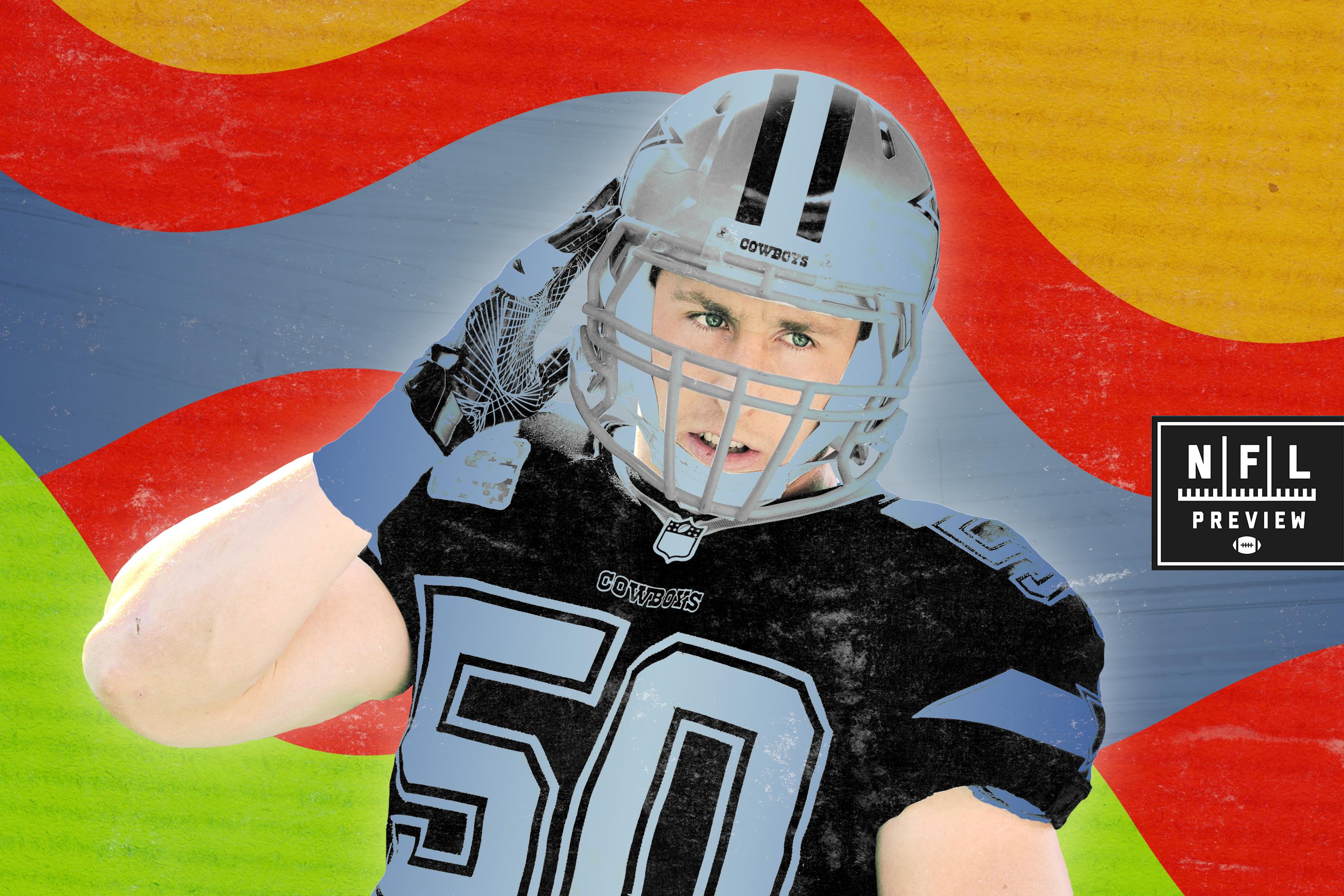
What’s valuable in the NFL? A great quarterback? Always—unless you’re the Eagles and can win with a backup. A great running back? Not usually—unless you’re the Rams and have Todd Gurley. A treasure chest of future second-round picks? Now you’re speaking Bill Belichick’s language. Welcome to Value Week, when we’ll be looking at what moves the needle for NFL teams—and what doesn’t.
It’s harder to define value in football than in any other sport. All-Pro teams, Pro Football Focus ratings, DVOA rankings, and average annual salaries are attempts to quantify value, but none quite scratch the itch. Where those means fail, Madden covers, YouTube highlight reels, viral plays, and spicy quotes fill in the gaps. The importance of a good quarterback is widely understood, the players who can sack those quarterbacks are paid handsomely, and the ball carriers and pass catchers prominent in fantasy football occupy more than their fair share of our mental real estate, but there are still plenty of players who don’t get their proper due, whether it’s in negotiations, in the box score, or in our minds. Drawing from that group, here are the five most undervalued players in the NFL.
Sean Lee, Linebacker, Dallas Cowboys
Cowboys fans know Lee is the key to their defense, and often their season. The Cowboys had the no. 1 rushing defense in 2016 in large part because of Lee, who can consistently beat offensive linemen to the point of attack, which in turn allows the defensive linemen to be aggressive in shooting their gaps. Like how Seattle’s defensive scheme long depended on Earl Thomas’s supernatural range at safety, Rod Marinelli’s aggressive defense depends on Lee avoiding blocks and filling gaps that most linebackers simply can’t reach on a consistent basis.
When Lee strained his hamstring in 2017, that defense stopped working. In the 10 games Lee played last season (excluding the Falcons game in which he left in the first quarter) the Cowboys gave up an average of 15.6 points per game, which across the whole season would have been the best in football last year. In the six games Lee missed, the Cowboys gave up more than 29 points per game, which would have been the worst in football in 2017. Unsurprisingly, Dallas was 1-5 without Lee and 8-2 with him in 2017. Some of that has to do with the schedule (Lee missed games against the Rams, the Aaron Rodgers–led Packers, and the Falcons) but it still illustrates how Lee is the fulcrum that allows the Dallas defense to operate. When he came back in 2017 (the first time), the difference was night and day.
Lee’s problem has long been his health—he played 17 out of 48 games games between 2012 and 2014—but when healthy, he’s one of the few players a team can build their entire defense around.
Harrison Smith, Safety, Minnesota Vikings
Smith has an uncanny knack for knowing where the ball will go. Operating in Minnesota’s complex system, Smith sees football like that Zach Galifianakis numbers meme.
“Sometimes he does such a good job of disguising [his plan] that I’m thinking, ‘Did he maybe get the wrong call?’” Vikings backup safety Anthony Harris told The Ringer’s Robert Mays in January. “‘Does he know something that I don’t know?’”
Not only does he fly all over the field, but Smith can do everything that is required of the modern safety at a top level. He can line up in one-on-one coverage in the slot or on the outside, break on balls as a roaming safety over the top, fill in against the run, rush the quarterback, and seal the edge. That versatility is part of why Smith was the highest-graded player in the secondary last year, according to PFF, and he’s also the only safety to ever earn a 99.9 grade in a game.
Despite his performance, Smith has the most tenuous place on this list, because his entire position has become undervalued. Eric Reid remains unsigned and Kenny Vaccaro, Tre Boston, and Tyrann Mathieu all signed one-year deals worth far less than it seemed they would get going into the offseason. This week, the Bengals released safety George Iloka with three years left on his five-year deal. It’s unknown whether the dip in the safety market is a one-year blip or a new trend, but Smith and Earl Thomas reign atop a shrinking kingdom.
David DeCastro, Guard, Pittsburgh Steelers
Individual linemen will never get their due, but DeCastro’s excellence deserves a spotlight. The Pittsburgh guard made the AP All-Pro first team in 2015 and 2017, but his name still barely registers among casual NFL fans. DeCastro was the no. 1 rated run blocker among guards by PFF and the no. 2 pass blocker. Of the 43 guards who played more than 800 snaps last year, DeCastro is one of four who did not allow a sack, and he allowed only one hit from the 14 hurries he surrendered. DeCastro is a nasty, quick, and complete blocker who can handle bull rushes from the league’s best, but also has the agility to make multiple blocks on the same play.
The next time Le’Veon Bell bursts through a hole for a 70-yard touchdown, look for no. 66 mowing people down ahead of him.
Kendall Fuller, Cornerback, Kansas City Chiefs
Washington threw Fuller into the trade for quarterback Alex Smith like he was an afterthought. But Fuller, a former third-round pick who would have been drafted much higher if he hadn’t gone down with a knee injury in college, was so good in his second NFL season that Kansas City felt comfortable trading All-Pro cornerback Marcus Peters to the Rams a day after acquiring the Virginia Tech product. Fuller played primarily from the slot in 2017, and by the end of the year he graded out as the best slot cornerback in the NFL by Bleacher Report’s NFL 1000 scouting grades. He was third among all corners in Pro Football Focus’s grading system. Fuller has excellent footwork and closing speed that allows him to break on balls quickly. Here’s Fuller beating Seahawks receiver Doug Baldwin to the ball on a third-and-4 slant that will give Seahawks fans flashbacks to Super Bowl XLIX.
Opposing quarterbacks had a 55.0 passer rating against Fuller in the slot, according to PFF, the lowest mark in football for slot cornerbacks. Fuller also showed he can make plays on balls at a high catch point, as he did on this game-sealing interception of Eli Manning on Thanksgiving.
Fuller won’t make the offseason headlines that Jalen Ramsey or Peters do, but on the field, his play is speaking for itself.
Grady Jarrett, Defensive Tackle, Atlanta Falcons
Before Brandon Graham strip-sacked Tom Brady to seal Super Bowl LII, Falcons defensive tackle Grady Jarrett was supposed to be the darling pass rusher credited with pummeling Brady to seal a Super Bowl victory.
Jarrett’s three-sack coming-out party in Super Bowl LI has been largely lost to the sands of time, but Falcons fans understand just how good Jarrett has been the past two years. Jarrett has the quickness to disrupt plays in the run game ...
… the IQ to sniff out trick plays ...
... and the agility to finish tackles in the backfield (sacking Cam Newton rarely looks this easy).
Hell, Jarrett almost intercepted a spike.
The Jets were flagged for not being set at the line, but this would have been one of the most improbable plays in recent memory if it stood.
Jarrett graded as the fifth-best run defender among interior linemen, tied with Michael Brockers behind Damon Harrison, Kawann Short, Ndamukong Suh, and Linval Joseph—guys who rank among the highest-paid players at the position. Jarrett, a fifth-round pick in 2015, is set for quite the payday when his contract expires at the end of this season, and he’ll deserve every penny.


